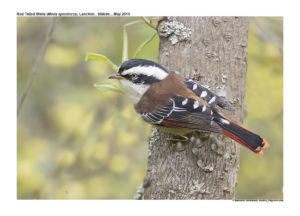
Red-tailed Minla Minla ignotincta
Etymology:
- Minla : Nepali Name
- Ignotincta : Latin word ignis- fire; tinctus -painted
Vernacular Names: Dafla: Pobhum dasim, Lepcha: Megblim-ayene, Megblim-adum, Nepal: Minla
Distribution in India: Resident in Himalayas and North East of India
Description: Size of 13–14·5 cm; wt. of 9·5–21 g. It is a small black-headed babbler with bold yellowish-white supercilium and throat, brown upperparts, pale yellow underparts and red in black tail. The male of nominate race has black crown and nape, long broad yellowish-white supercilium, narrow white eyering broken at front and rear, broad black mask from lores through ear-coverts to nape and neck side. The upperparts are maroon-brown, shading to ochrous on rump and uppertail-coverts; upperwing is black, wing-coverts have white fringes and tips, primaries have red basal fringes turning yellower towards tips, tail is black with red and some white edges of feathers. The submoustachial and malar areas are white; chin and throat are yellowish-white, becoming pale yellow with vague long greyish streaks on underparts. The iris is pale yellow to cream, sometimes brown; bill is blackish-brown, paler horn on lower mandible; legs are olive-brown to yellowish-horn. The female has dorsal maroon-brown replaced by dull greyish-brown to olive-brown, paler pinkish-yellow to whitish fringing on wings and tail. The juvenile is like female, but mantle is slightly darker and white plumage parts are duller, with faint dark scales below.
Habitat: It found in the broad leaf evergreen and mixed broadleaf-conifer forest, sometimes pine forest and deciduous forest.
Food Habits: They eat mainly insects and their larvae and sometimes seeds. Usually found in parties of considerable size; often joins bird waves. This helps them in searching for food and protection from predators
Breeding Habits: The breeding period is from Apr–Jun. Nest is a beautiful, small pendant-shaped cup or rather deep purse, made of fine green moss and rootlets, well hidden from predators. Two to Four eggs are laid in the nest. The Chicks are Precocial (with open eyes and down feathers). They are fed insects for faster growth and water content. The chicks grow faster and leave the nest within 2 weeks.